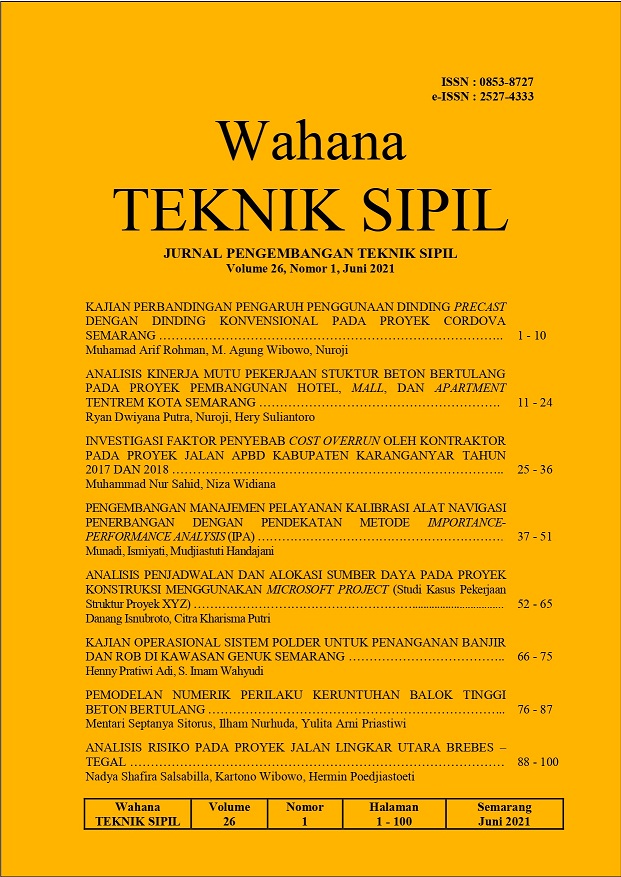ANALISIS RISIKO PADA PROYEK JALAN LINGKAR UTARA BREBES - TEGAL
DOI:
https://doi.org/10.32497/wahanats.v26i1.2814Keywords:
risk, ring road project, frequency and impact matrixAbstract
Risk is a consequence of uncertain conditions. Risk will always exist in every construction project because basically a construction project is a unique, dynamic and risky activity. The purpose of this research is to analyze the risks in the construction project of the North Ring Road Brebes - Tegal and the purpose of this study is to identify risks, conduct risk level assessments and handle high risks that affect the project. This study uses two data, namely secondary data and primary data. Primary data, namely risk identification data, risk level data and risk response data. Secondary data, namely organizational structure data. The data that has been obtained are then analyzed using the Probability and Impact Matrix (PIM) method and followed by calculating the risk level value. Based on this value, the category and ranking of each risk is then determined. In the last stage, analysis of the handling of the highest risk is carried out. The results of the risk identification analysis of this study obtained 33 risks, then the results of the analysis using the Probability and Impact Matrix (PIM) method obtained 3 (three) high risks, namely incomplete design data, conflicts of interest with residents, inadequate project information (soil testing and reports survey). Ten risks fall into the moderate category and 20 other risks fall into the low category.
References
Arikunto, S., 2012, Prosedur
Penelitian Suatu Pendekatan
Praktek. Jakarta: Rineka Cipta
Asmarantaka, 2014, Analisis Risiko
yang Berpengaruh Terhadap
Kinerja Proyek pada
Pembangunan Hotel Batiqa
Palembang. In : Jurnal Teknik
Sipil dan Lingkungan, Vol. 2,
no. 3, pp. 483-491.
Choudhry, R.M., and Aslam, M.A.,
, Risk Analysis of Bridge
Construction Projects in
Pakistan. Proceedings of
International Council for
Research and Innovation in
Building and Construction
(CIB). Purdue University.
Darmawi, H., 2008, Managemen
Risiko. Jakarta: Bumi Aksara.
Fandopa, Riza, 2012, Pengelolaan
Risiko pada Pelaksanaan
Proyek Jalan Perkerasan
Lentur PT X dalam rangka
Meningkatkan Kinerja Mutu
Proyek. Tesis Universitas
Indonesia, Indonesia.
Flanangan, R & Norman, G., 1993,
Risk Management and
Construction, London :
Blackwell Science
Iacob, V.S., 2014, Risk Management
and Evaluation and Qualitative
Method Within The Project.
Ecovorum, Vol.3, Issue 1, pp:
-67.
International Standard, 2009, Risk
Management-Principles and
Guidelines. Geneva:ISO.
Project Management Institute, 2013, A
Guide to the Project
Management Body of
Knowledge ”“ Fifth Edition
PMBOK. Project ManagementInstitute,
Inc. Pennsylvania.
Soeharto, Iman, 1999, Manajemen
Proyek (Dari Konseptual
sampai Operasional) Jilid I.
Jakarta: PT. Gelora Aksara
Pratama.
Soemarno, M.S, 2007, Risiko
Penggunaan Lahan dan
Analisisnya Laboratorium
PPJP Jurusan Tanah, Malang.
Sonhadji, 2011, Manajemen Risiko
Dalam Project Jalan Tol. Tesis
Universitas Islam Sultan
Agung, Semarang.
Sugiyono, 2008, Statistika untuk
Penelitian. Alfabeta. Bandung.
Taufik, H.A.R.M., 2010, Pengelolaan
Risiko Kualitas pada Tahap
Pelaksanaan Konstruksi di
Lingkungan PT. X. Tesis
Universitas Indonesia,
Indonesia.
Vidivelli, B., Vidhyasagar, E., and
Jayasudha, K., 2017, “Risk
Analysis in Bridge
Construction Projects”. In :
International Journal of
Innovative Research in Science,
Engineering and Technology,
Vol. 6 no. 5, pp 8271-8284.
Wiguna, I.P.A., and Scott, S., 2006,
Relating Risk To Project
Performance In Indonesian
Building Contracts. In :
Journal Construction
Management and Economics,
Vol. 24, no. 11, pp. 1125”“
Winaktu, G., 2014, “Penentuan Skala
Prioritas Risiko pada
Pembangunan Jembatan Afiat
Desa Kanigoro Kecamatan
Pagelaran Kabupaten
Malang”. In : Jurnal Info
Manajemen Proyek pp. 11-19
Zou, Zhang, G., and Wang, J.Y., 2006,
Indentifying Key Risk in
Construction Projects: Life
Cycle and Stakeholder
Perspectives.
Downloads
Published
Issue
Section
License
Authors who publish with this journal agree to the following terms:Authors retain copyright and grant the journal right of first publication with the work simultaneously licensed under a Creative Commons Attribution License that allows others to share the work with an acknowledgement of the work's authorship and initial publication in this journal.
Authors are able to enter into separate, additional contractual arrangements for the non-exclusive distribution of the journal's published version of the work (e.g., post it to an institutional repository or publish it in a book), with an acknowledgement of its initial publication in this journal.
Authors are permitted and encouraged to post their work online (e.g., in institutional repositories or on their website) prior to and during the submission process, as it can lead to productive exchanges, as well as earlier and greater citation of published work (See The Effect of Open Access).






